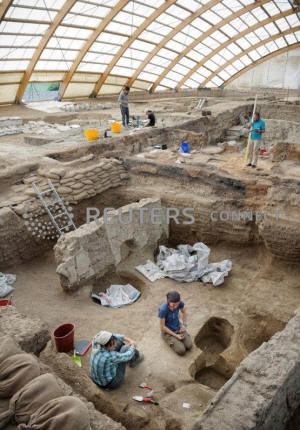|
Prehistoric settlement in Turkey bears
telltale signs of modern woes
 Send a link to a friend
Send a link to a friend
 [June 18, 2019]
By Will Dunham [June 18, 2019]
By Will Dunham
WASHINGTON (Reuters) - Overcrowding.
Violence. Infectious diseases. Environmental degradation. It may sound
like the worst of modern mega-cities.
But people encountered these very same problems when the first large
settlements were being established millennia ago as humans began to swap
a nomadic hunter-gatherer existence for a lifestyle centered on farming,
scientists said on Monday, based on findings from a prehistoric site in
south-central Turkey.
The researchers examined 742 human skeletons unearthed at the
prehistoric ruins of Catalhoyuk, inhabited from 9,100 to 7,950 years ago
during a pivotal time in human evolution, for clues about what life was
like at one of the earliest sizable settlements in the archeological
record. At its peak, 3,500 to 8,000 people lived there, with the
researchers calling it a "proto-city."
The residents experienced a high rate of infections, as seen in their
teeth and bones, probably caused by diseases spreading in crowded
conditions amid challenges to proper hygiene, the researchers said.
Overcrowding may have contributed to interpersonal violence. Many skulls
bore evidence of healed fractures to the top or back of the cranium,
some with multiple injuries.

The shape of these injuries indicates they may have been caused by hard
clay balls found at Catalhoyuk that researchers suspect were used as
projectiles from a sling weapon
"A key message that people will take from these findings is that our
current behaviors have deep roots in the history of humankind," said
Ohio State University biological anthropologist Clark Spencer Larsen,
who led the study published in the Proceedings of the National Academy
of Sciences.
"The people living in this community faced challenges of life in
settlements addressing fundamental issues: what to eat, who produces the
food, how is the food distributed, what are the social norms for
division of labor, the challenges of infection and infectious disease in
settings where there is limited sanitation, the strategy of
interpersonal relationships involving animosity in some instances,"
Larsen added.
[to top of second column]
|

Researchers excavate the ruins of Catalhoyuk, a prehistoric
settlement located in south-central Turkey that was inhabited from
about 9,100 to 7,950 years ago, in this photograph released from
Istanbul, Turkey, June 17, 2019. Scott Haddow/Handout via REUTERS

As the world emerged from the last Ice Age, with warmer conditions
conducive to crop domestication, there was a shift from foraging to
farming beginning 10,000 to 12,000 years ago among people in
numerous places.
The people grew crops including wheat, barley and rye and raised
sheep, goats and eventually cattle. Some homes boasted wall murals,
and other art included stone figurines of animals and corpulent
women.
Catalhoyuk's residents lived in clay brick structures akin to
apartments, entering and exiting through ladders that connected the
living areas of houses to the roofs. After
death, residents were buried in pits dug into the floors of the
homes.
Catalhoyuk, measuring about 32 acres (13 hectares), was continuously
occupied for 1,150 years and appears to have been a largely
egalitarian community. It was eventually abandoned perhaps because
of environmental degradation caused by the human population and a
drying climate that made farming there harder, the researchers said.
(Reporting by Will Dunham; Editing by Sandra Maler)
[© 2019 Thomson Reuters. All rights
reserved.]
Copyright 2019 Reuters. All rights reserved. This material may not be published,
broadcast, rewritten or redistributed.
Thompson Reuters is solely responsible for this content.
 |